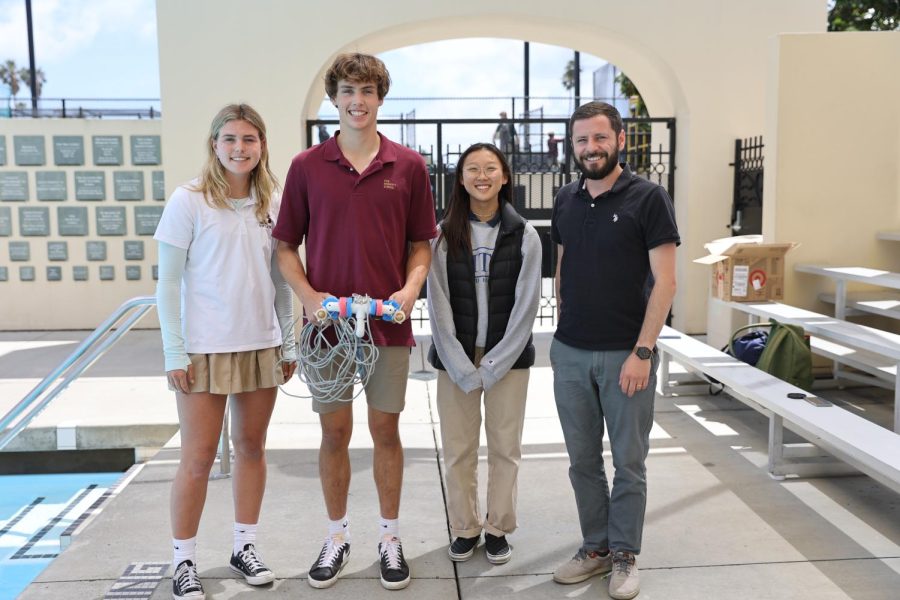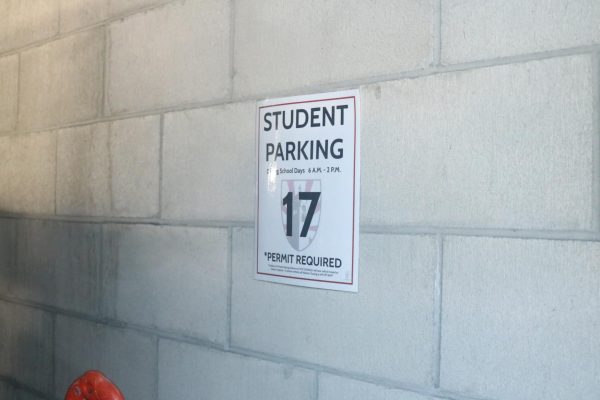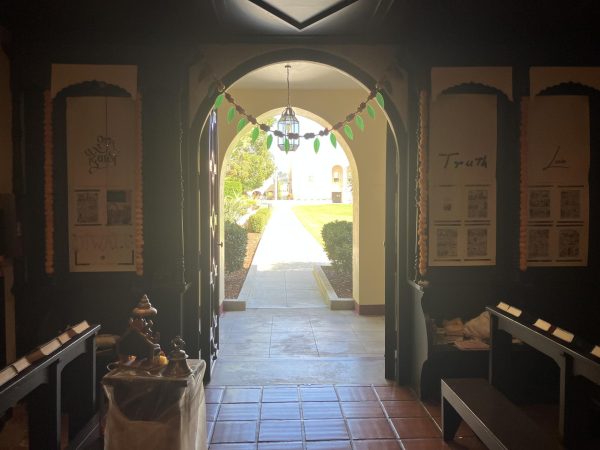Sea you in Maryland
A look at the Bishop’s team who made the national level SeaPerch robotics competition
(From left to right) Lexi Black (’24), Hewitt Watkins (’23), Emily Zhu (’23) and Mr. Joshua Bloom take a picture with their ROV that they designed over the course of a couple of months.
Finding a way to incorporate science and creativity to build a fully functioning and versatile vehicle is difficult. Qualifying and attending a national level competition is even harder. Being the first ones at Bishops to make a national competition is perhaps the most impressive of all. But Emily Zhu (‘23), Hewitt Watkins (‘23) and Lexi Black (‘24) accomplished all three of these feats in a robotics competition called SeaPerch. Due to their amazing performance, they’ll stay in dorms at the University of Maryland to participate in the national level competition for SeaPerch on June 4 this year.
SeaPerch is a robotics competition where participants build their own robot, or ROV, and complete a series of obstacles and challenges. One competition is centered around completing tasks while the other one is navigating an obstacle course, according to SeaPerch Coach Mr. Joshua Bloom. It’s also entirely underwater. Hence the name, the robot has to be waterproof, agile, and strong enough in order to complete the assignments at hand.
For each SeaPerch competition, there’s a different theme and different tasks. One year, the theme was centered around the Thai soccer team that got stuck in a cave. As a result, the tasks that year were navigating an obstacle course and trying to retrieve a broken down robot, similar to the situation in Thailand. This year, the theme was space exploration, so the teams moved objects nicknamed “batteries” as part of their challenge. The team’s ROV needed to be able to turn the handle of an underwater compartment, retrieve the batteries and place them on a platform. Mr. Bloom expressed the complexity of the task by saying that “the challenge was to make something small enough and quick enough to navigate the obstacle course but also big enough and strong enough to be able to carry one of [the] batteries.” He also added that “this year’s challenge was definitely more complex than in previous years.”

Hewitt, Lexi, and Emily began preparing for the competition around January and February. It started out as all three “meeting once a week and pretty lowkey” since “[they] all love robotics and it’s pretty fun,” Hewitt explained. Then for research, Emily mentioned how the team watched YouTube videos and then decided on a conventional design for their ROV. The team, however, decided to change the structure and shape of their robot to make it lighter. Emily elaborated that this was a risk the team took since their design had been untested. After testing their design and finding it to be successful, they began fine-tuning their robot, such as improving weight distribution and other adjustments.
The robot that the team used is equally, if not more complex than the obstacle course. Mr. Bloom described that “you have three motors that are on your ROV which you’re using to turn right turn left and to go up and down” and the goal is to “keep it small enough that it’s easy to navigate and quick to turn but also that’s too small and it can’t carry some of these objects.” While diving into a more technical aspect of the design, Emily stated that while designing the robot there’s “a lot of thinking about the physics.” Hewitt also elaborated that in previous years, he had to “[deal] with [a whole] buoyancy problem” but since he already had experience, so the team “went straight into making a new design” with the goal of making it “as maneuverable as possible” in mind.
During their design process, the team had largely worked on it by themselves. “I was pretty hands off with that group. I mostly worked with the middle school teams that were taking the robotics 8 class” Mr. Bloom stated. However, the team had quite a lot of expertise as Mr. Bloom states how “all of them had taken the 8th grade course and so they already understood what was expected and where they needed to get in time for the competition.” The team then went on to participate in regionals and Mr. Bloom described how the “kids had a great time.” Due to COVID, however, Hewitt and his team were unable to participate in SeaPerch until this year, when he created a team with his friends and designed the ROV.
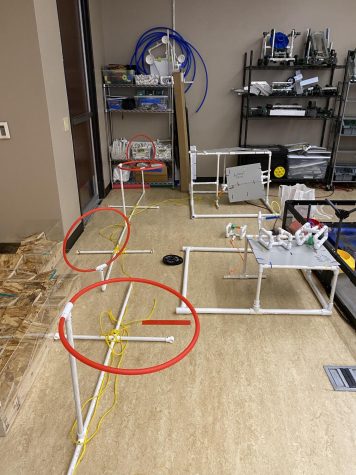
Despite the complex nature of the competition, the team has maintained a positive outlook. Emily explained that she “chose SeaPerch because [she] thought it was really interesting” and “really wanted that experience of thinking through stuff.” Emily also stated “I really wanted to work as a team especially [because] I think that’s really important and I feel like a team really helps build you up.” “We just did it because we like robotics” and “we went in with the goal of just having fun” Hewitt adds. Along with that, Hewitt also said “We put our best foot forward and we didn’t go in with any expectations of doing anything, we just wanted to compete.” What Hewitt kept in mind the most, however, was “first and foremost, [to] have fun with this and let our vision come to fruition.”
The team members also exhibited their passion for robotics. Hewitt stated “I just absolutely [love] the feeling of making something from start to finish and it working and working reliably. There’s no better feeling than putting the ROV in the pool and watching it fly around knowing that it came from your design and you put those pieces together.”
As the team heads off to Maryland for the national competition, Hewitt said, “I’m just so excited to see where we go in nationals this year and if we fall short, I feel like we might have to come back to the water, but I don’t know, I’m just really looking forward to it.” With students like Hewitt, Emily and Lexi, the future of SeaPerch and robotics in general is looking bright. “This was the first team that qualified for nationals but I’m sure, going forward, we will have more,” Mr. Bloom said. “We have a lot of interest in robotics and a huge robotics club in the upper school.”
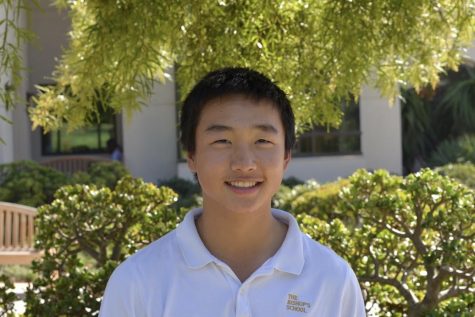
Kayden came to Bishops in 8th grade and became a staff writer for The Tower this year. He joined The Tower since he wanted to improve his writing, learn...


